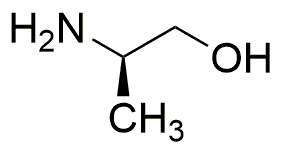D-Alaninol is widely utilized in research focused on
- Pharmaceutical Development: It serves as a building block in the synthesis of various pharmaceuticals, particularly in the creation of amino acid derivatives that can enhance drug efficacy.
- Biotechnology: This compound is used in the production of peptides and proteins, contributing to advancements in therapeutic proteins and enzyme production.
- Cosmetic Formulations: D-Alaninol acts as a moisturizing agent in skincare products, improving skin hydration and texture, making it a popular choice in the cosmetic industry.
- Food Industry: It is employed as a flavoring agent, providing a unique taste profile in food products, which can enhance consumer appeal.
- Research Applications: In academic and industrial research, it is utilized in studies related to amino acid metabolism and neurobiology, aiding in the understanding of various biological processes.
General Information
Properties
Safety and Regulations
Applications
D-Alaninol is widely utilized in research focused on
- Pharmaceutical Development: It serves as a building block in the synthesis of various pharmaceuticals, particularly in the creation of amino acid derivatives that can enhance drug efficacy.
- Biotechnology: This compound is used in the production of peptides and proteins, contributing to advancements in therapeutic proteins and enzyme production.
- Cosmetic Formulations: D-Alaninol acts as a moisturizing agent in skincare products, improving skin hydration and texture, making it a popular choice in the cosmetic industry.
- Food Industry: It is employed as a flavoring agent, providing a unique taste profile in food products, which can enhance consumer appeal.
- Research Applications: In academic and industrial research, it is utilized in studies related to amino acid metabolism and neurobiology, aiding in the understanding of various biological processes.
Documents
Safety Data Sheets (SDS)
The SDS provides comprehensive safety information on handling, storage, and disposal of the product.
Product Specification (PS)
The PS provides a comprehensive breakdown of the product’s properties, including chemical composition, physical state, purity, and storage requirements. It also details acceptable quality ranges and the product's intended applications.
Certificates of Analysis (COA)
Search for Certificates of Analysis (COA) by entering the products Lot Number. Lot and Batch Numbers can be found on a product’s label following the words ‘Lot’ or ‘Batch’.
*Catalog Number
*Lot Number
Certificates Of Origin (COO)
This COO confirms the country where the product was manufactured, and also details the materials and components used in it and whether it is derived from natural, synthetic, or other specific sources. This certificate may be required for customs, trade, and regulatory compliance.
*Catalog Number
*Lot Number
Safety Data Sheets (SDS)
The SDS provides comprehensive safety information on handling, storage, and disposal of the product.
DownloadProduct Specification (PS)
The PS provides a comprehensive breakdown of the product’s properties, including chemical composition, physical state, purity, and storage requirements. It also details acceptable quality ranges and the product's intended applications.
DownloadCertificates of Analysis (COA)
Search for Certificates of Analysis (COA) by entering the products Lot Number. Lot and Batch Numbers can be found on a product’s label following the words ‘Lot’ or ‘Batch’.
*Catalog Number
*Lot Number
Certificates Of Origin (COO)
This COO confirms the country where the product was manufactured, and also details the materials and components used in it and whether it is derived from natural, synthetic, or other specific sources. This certificate may be required for customs, trade, and regulatory compliance.


